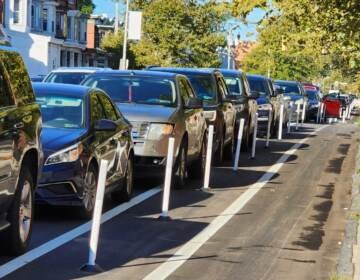Pedestrian deaths on the rise in Philadelphia
2020 is shaping up to be a dangerous year for people walking near moving traffic with city crash data showing a startling 88% spike in pedestrian deaths.

A pedestrian crosses Roosevelt Boulevard at Rising Sun Avenue. (Emma Lee/WHYY)
Seventeen people were killed by motor vehicles while walking on Philadelphia streets in the first three months of 2020, an analysis of city crash data shows.
The 17 deaths represent a startling 88% spike over the same period last year when traffic accidents killed eight pedestrians, according to the analysis done by the Bicycle Coalition of Greater Philadelphia.
The advocacy group — using the Philadelphia Police Department’s Accident Investigation Unit’s Fatal Crashes report — found that the pedestrian deaths amount to more than half of 2020’s traffic fatalities so far.
Crash summaries include details that show all the ways in which city traffic can become deadly. Some reports mention pedestrian intoxication and jaywalking as causes while others mention vehicles going in the wrong direction, traveling at high speeds or running red lights.
Notably, two fatalities occurred on the city’s deadliest road — Roosevelt Blvd— where speed cameras were installed this winter after years of advocacy from nearby residents.
A bus struck one of the pedestrians killed in 2020 while a trolley car struck another. Most of the 17 fatalities were identified as male, with only three identified as female. Ages of victims range from 27 to 83. No bicyclists have been killed in Philadelphia this year to date.
The collisions happened across the city with a high concentration in North Philadelphia. While the report does not contain information about the racial identities of traffic victims, the areas where the most traffic fatalities occurred have largely non-white populations.
Mayor Jim Kenney has committed to Vision Zero, a plan to reduce traffic-related deaths to zero by 2030. In 2017, Philadelphia had a total of 78 traffic deaths, the lowest since 2014. That number rose by 17% in 2018 to 91 deaths.
Last year, in 2019, the total was 90. The new Bicycle Coalition report indicates that 2020 could end with a higher total number of deaths, despite the high-profile traffic safety initiative.
“This current spike in traffic fatalities shows that the progress towards Vision Zero in the city is going in the wrong direction,” the report’s authors wrote.
The COVID-19 pandemic has mobilized advocates, neighborhood associations and councilmembers to call for more streets to be closed to cars and open for pedestrian and cyclist-use only.
“If Philadelphia had the needed infrastructure already in place, like an expanded bicycle network, safer pedestrian crossings, wider sidewalks, and the dedicated space that pedestrians, transit riders, and people on bicycles need, we wouldn’t be seeing this sort of uptick in pedestrian deaths right now,” said Randy LoBasso, policy director at the Bicycle Coalition.
Another potential remedy for traffic fatalities could be neighborhood slow zones, he said.
“Slow zones, which use road design tactics to curb speed, have been regularly used to bring down speed and combat traffic deaths, simply because they use road design to slow everyone down,” LoBasso said.
He and other advocates say the slow zones are a low-budget solution able to be implemented with a few signs and barricades. That opinion isn’t shared by members of the Kenney administration who say the traffic restrictions require infrastructure and police enforcement.
Construction on the city’s first two slow zones, initiated last year, is on hold because of the pandemic and more of them are unlikely for now, the city’s Managing Director Brian Abernathy told PlanPhilly last week.
“Neighborhood slow zones cost money, and frankly, we’re going to have to prioritize all our resources and our programs going forward,” Abernathy said.
WHYY is your source for fact-based, in-depth journalism and information. As a nonprofit organization, we rely on financial support from readers like you. Please give today.






